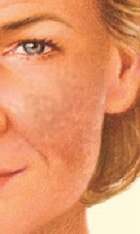CO2 LASER
IF YOU’RE CONSIDERING LASER RESURFACING …
Video
A WORD ABOUT THE LASER
Laser resurfacing is performed using a beam of laser energy which vaporizes the upper layers of damaged skin at specific and controlled levels of penetration. It’s clear that laser resurfacing may offer a number of advantages over other resurfacing methods: precision, little (if any) bleeding and less post-operative discomfort. However, laser resurfacing isn’t for everyone. In some cases, an alternative skin resurfacing treatment, such as dermabrasion or chemical peel, may still be a better choice. All resurfacing treatments work essentially the same way. First, the outer layers of damaged skin are stripped away. Then, as new cells form during the healing process, a smoother, tighter, younger-looking skin surface appears. Laser resurfacing is a new method being used by plastic surgeons to remove damaged skin. Because it is new, there are no long-term data on this technique. However, a number of studies using microscopic examination have shown that the physical changes that occur to laser-treated skin are essentially identical to those that occur with either dermabrasion or chemical peel. Ask your plastic surgeon about the latest facts concerning long-term follow-up. For superficial or medium resurfacing, the laser can be limited to the epidermis and papillary dermis. For deeper resurfacing, the upper levels of the reticulas dermis can also be removed. Varied penetration allows treatment of specific spots or wrinkles. It’s also important to consider the length of recovery when choosing among the skin-resurfacing alternatives. In general, the more aggressive the resurfacing procedure is, the more prolonged the recovery is likely to be. “Light” resurfacing procedures, such as superficial chemical peels or superficial laser resurfacing, offer shorter recovery times. However, these lighter procedures may need to be repeated multiple times to achieve results comparable to those achieved with more aggressive techniques.THE BEST CANDIDATES FOR LASER RESURFACING
In many cases, facial wrinkles form in localized areas, such as near the eyes or around the mouth. The laser can be precisely controlled so that only these specific areas are targeted.
Men and women of all ages can benefit from laser resurfacing. The ideal patient for laser resurfacing has fair, healthy, non-oily skin.

When healing is complete, the face has a more youthful appearance.
ALL SURGERY CARRIES SOME UNCERTAINTY AND RISK
When laser resurfacing is performed by a qualified, experienced surgeon, complications are infrequent and usually minor. However, because individuals vary greatly in their anatomy, their physical reactions and their healing abilities, the outcome is never completely predictable. Risks associated with laser resurfacing include: burns or other injuries from the heat of the laser energy, scarring, and obvious lightening or darkening of the treated skin. Also, laser resurfacing can activate herpes virus infections (“cold sores”) and, rarely, other types of infection. Additional corrective measures and treatment may be required if healing seems abnormal or delayed or if there is any evidence of abnormal pigmentation or scarring. You can reduce your risks by choosing a qualified plastic surgeon who has received special training in laser surgery.PLANNING YOUR SURGERY
Not every practitioner who offers laser surgery has the same level of experience and skill with laser use. That is why it is especially important that you find a plastic surgeon who is adequately trained in the procedure. One safety measure is to find out whether your surgeon has privileges to perform laser resurfacing with a CO2 laser at an accredited hospital. Even if the operation is to be conducted in your doctor’s private facility, the fact that he or she has privileges to use that same laser in a hospital ensures that the doctor has been reviewed by the institution’s experts. In your initial consultation, be frank in discussing your expectations with the surgeon and don’t hesitate to ask any questions you may have. Your surgeon should be equally frank with you, explaining the factors that could influence the procedure and the results – such as any abnormal skin condition which has been diagnosed or previously treated, medications you are taking or have taken in the past, previous skin injuries or previous operations. Your surgeon will discuss your medical history, perform a routine examination and photograph the area to be treated. He or she should explain the procedure in detail, along with its risks and benefits, the recovery period and the costs. Remember, cosmetic laser treatments can be expensive and are usually not covered by medical insurance. On rare occasions, the procedure can be used for modification of scars or the removal of pre-cancerous skin growths. These conditions could meet the criteria for “medical necessity,” usually required by insurance companies before coverage will be provided. Your plastic surgeon can advise you how to contact your insurance carrier to determine whether benefits will be allowed in such instances.PREPARING FOR THE LASER PROCEDURE
Depending on your individual needs, your surgeon may recommend that you begin a pre-treatment plan to prepare the skin for resurfacing. At the time of the procedure, you will be given specific instructions on how to care for your skin immediately following your laser treatment. Your surgeon may also instruct you to follow a specific maintenance regimen for long-term care of the skin to maximize the benefits of the procedure. While you are making plans, be sure to make arrangements for someone to drive you home if you will be given tranquilizers or sedation for your laser treatment.WHERE YOUR LASER TREATMENT WILL BE PERFORMED
Laser resurfacing may be performed in a hospital, an outpatient surgery center or a surgeon’s office-based facility. For cost containment and convenience, laser resurfacing is usually done on an outpatient basis. For the more extensive resurfacing procedures or for resurfacing combined with other surgical procedures, you may be admitted to a hospital or a recovery center.TYPES OF ANESTHESIA
Laser resurfacing is most commonly performed under local anesthesia with sedation, especially when it’s used to treat localized areas of the face. You’ll be awake but relaxed, and will feel minimal discomfort. For more extensive resurfacing, your surgeon may prefer to use general anesthesia, in which case you’ll sleep through the procedure.THE PROCEDURE
Laser resurfacing is a relatively quick procedure. It usually takes anywhere from a few minutes to 1 1/2 hours, depending on how large of an area is involved.
When the imperfections are especially deep, your surgeon may recommend that the resurfacing be performed in two or more stages.
During the procedure, the activated laser is carefully passed back and forth over the skin until the surgeon reaches the level that will make the wrinkle or scar less visible.
When the procedure is over, your surgeon may choose to treat the resurfaced skin with applications of protective creams or ointments until healing is complete. Some surgeons choose to apply a bandage over the treated areas which will cover and protect the healing skin for the first five to ten days.

The brown discoloration commonly experienced with age and sun exposure can be treated with laser resurfacing.

When healing is complete, the skin is more homogeneously glowing with noticeably less skin discoloration.
AFTER YOUR TREATMENT
You are likely to experience some mild swelling and discomfort after laser resurfacing. However, this can be controlled with ice packs and medications prescribed by your surgeon. If a bandage was applied after your procedure, it may be replaced with a fresh one after a day or two. After about a week or so, your bandage will be removed and a thin layer of ointment may be applied to the skin. Once this stage is reached, your surgeon will provide instructions on how to gently wash and care for your healing skin. During this phase of healing, it is very important that you not pick the crusts off the treated area or scarring may result. Most patients are free of crusts by about 10 days post-operatively. Redness may persist for several weeks.GETTING BACK TO NORMAL
Your new skin will usually remain bright pink to red in the weeks following the procedure. Your surgeon may prescribe medications to make this color subside more rapidly. After about two weeks or so, most patients can safely apply makeup to conceal this temporary color change. However, some pinkness may remain for up to six months. It is rare, some patients may find that their healing skin is unusually sensitive to the makeup that was regularly used prior to treatment. In such instances, makeup should be avoided until a substitute can be found or until the healing progresses to a point at which the makeup no longer causes a reaction. Above all, in the months following treatment, it’s important to protect the treated area from the sun until all the color has returned to normal. Using sun protection regularly will help to maintain your results and reduce the chance of any new sun damage to your skin. If you must be in the sun, apply a strong sun block with an SPF of 15 or higher and shade your face with a hat or visor. If resurfacing was performed around the eyes, it’s best to also wear good quality sunglasses with UVA and UVB 100 percent filters.YOUR NEW LOOK
The final result from laser resurfacing may take several months to fully appear. However, once the pinkness fades, patients usually notice a significant improvement in the quality of their skin and a fresher, smoother appearance. It’s important to understand that your results will be long-lasting, but not permanent. Remember, your new skin is not immune to the effects of aging. In the months and years following your laser treatment, your natural facial movements will eventually cause any “expression” lines to recur. As with other methods of skin rejuvenation, laser treatments can usually be repeated. However, by protecting yourself from the sun and following a skin-care regimen recommended by your plastic surgeon, you can help maintain your rejuvenated look. The preceding information was provided by the ASPS at www.plasticsurgery.orgFRAXEL LASER
 The gold standard in reversing the signs of aging has been with the CO2 laser. Resurfacing is achieved by vaporizing layers of skin while causing tissue contraction. Although this modality achieves dramatic results, candidates often undergo general anesthesia and prolonged healing and recovery times (as long as two weeks). Brown spots and deep wrinkles can be removed with this technique.
The new treatment which will change the way we view permanent skin rejuvenation is called Fraxel™. Fraxel™ Laser Therapy, achieves its results by resurfacing the skin 15-25% at each session. This is done by separating the large continous laser beam into many smaller ones, so that there remains untouched skin in between these separated beams. This process results in microscopically deep columns of treatment areas named microthermal zones surrounded by zones of healthy skin tissue. This fractional treatment allows the skin to heal much faster than if it were treated all at once, using the body’s natural healing process to create new healthy tissue to replace skin imperfections, remodel collagen and tighten skin texture.
The gold standard in reversing the signs of aging has been with the CO2 laser. Resurfacing is achieved by vaporizing layers of skin while causing tissue contraction. Although this modality achieves dramatic results, candidates often undergo general anesthesia and prolonged healing and recovery times (as long as two weeks). Brown spots and deep wrinkles can be removed with this technique.
The new treatment which will change the way we view permanent skin rejuvenation is called Fraxel™. Fraxel™ Laser Therapy, achieves its results by resurfacing the skin 15-25% at each session. This is done by separating the large continous laser beam into many smaller ones, so that there remains untouched skin in between these separated beams. This process results in microscopically deep columns of treatment areas named microthermal zones surrounded by zones of healthy skin tissue. This fractional treatment allows the skin to heal much faster than if it were treated all at once, using the body’s natural healing process to create new healthy tissue to replace skin imperfections, remodel collagen and tighten skin texture.


